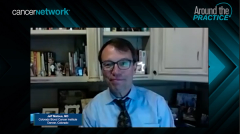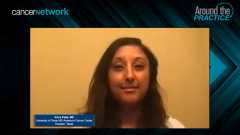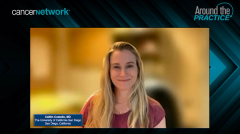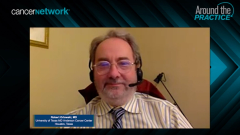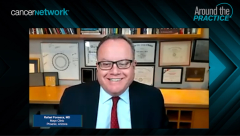
Choosing Between Triplet and Quadruplet Induction Regimens for Transplant-Eligible NDMM
A discussion on choosing between triplet or quadruplet induction therapy for transplant-eligible newly diagnosed multiple myeloma.
Episodes in this series

Rafael Fonseca, MD: Before we open it up for a general conversation, we of course also had the German study, the GMMG-HD7, which now uses isatuximab. Dr Matous, can you briefly describe the study and also what is your interpretation, your meta-narrative if you may, of what that study tells us?
Jeff Matous, MD: It’s GRIFFIN-like with isatuximab instead of daratumumab, so a different anti-CD38 monoclonal antibody. In this trial, and who else could do this but the Germans, in just under 2 years, they enrolled 660 patients in 67 centers around the country on this trial, which was for transplant-eligible patients. The induction was [isatuximab] and RVd [lenalidomide, bortezomib, dexamethasone] versus RVd, so again, a quadruplet versus a triplet, and the primary end point of the study was MRD [minimal residual disease] negativity by flow cytometry to 10-5. The trial was reported relatively early, just after the induction phase. The intent of this study, again, is to take patients to transplant and with post-transplant care, of course. Now, in the induction phase, the CR [complete response] rates between the 2 groups of patients were very similar, in the order of 20% to 25%. But the MRD negativity rates strongly favored the quadruplet over the triplet, about 50% versus about 36%. And what’s always good to see when we see these trials is that there’s no additional safety signal that has emerged, at least over the induction phase of the trial. So again, it’s early reporting of the trial, but looking very feasible again for incorporating an anti-CD38 monoclonal antibody on top of the RVd backbone, Dr Fonseca.
Rafael Fonseca, MD: Thank you. I think the results were very well received and quite exciting, so let’s try to put all of this together. Dr Orlowski, as you think about the treatment of transplant-eligible patients, how do you decide which patients should get triplet or quad? Or perhaps even better yet, is there any situation where you think we could argue now for a triplet drug combination? What are your thoughts in that regard?
Robert Orlowski, MD: In terms of the quadruplet, and here we’d be talking about a CD38 antibody, a proteasome inhibitor, an IMiD [immunomodulatory imide drug], and a steroid, I’ve moved to using quadruplets for every patient with high-risk disease in the newly diagnosed setting because we know that they have more difficult disease. Although it responds well, it tends to relapse more quickly, and the deeper responses, the greater MRD negativity, I think is what we need to achieve there. And I also tend to do this for people with a high degree of disease burden. Same rationale there. If you’ve got 10% plasma cells at baseline, it’s easier to get you into a complete remission and MRD negativity than if you’re, say, 75%. I think where the question comes is, where do you draw the line between high disease burden and lower disease burden? I sort of arbitrarily, quite frankly, say 50% plasma cells or more. But I do think in the future we probably will be doing 4 drugs for virtually everybody unless there will be a compelling reason why 1 of those 4 drugs is contraindicated in a patient.
Rafael Fonseca, MD: Let me push a little on that concept, and we’ve talked about this before with you, wouldn’t it also make sense given the benefit that we see that perhaps that benefit is even more pronounced in those patients with standard-risk disease? In other words, does it even make sense or is there a future where maybe risk stratification will become slightly less important?
Robert Orlowski, MD: I think it’s a great point, and certainly there is a possibility that we’ll be doing 4 drugs even for standard-risk, low disease burden patients at the time of diagnosis. I think what we’d probably all like to see is use of some kind of early measure of response, where maybe we could do a response-adaptive therapy. Because clearly there are people who are already going to achieve CR and MRD negativity just with a triplet, and if you get to MRD negative, it’s not clear that the addition of another agent is of benefit. So, I think ideally it would be nice to have that kind of assay at the beginning to work with.
Rafael Fonseca, MD: Thank you. Dr Matous, you have a very unique perspective because of where you practice, an academically active and oriented private practice in a community center. So, what are your thoughts regarding these combinations, the use of the triplets versus the quads? And does it matter in the setting that we’re doing this, or should it be an expectation across the board?
Jeff Matous, MD: I can tell you that patients who are referred to us for transplant are primarily still getting RVd. Some of the practitioners have adopted a quad, daratumumab with RVd in this case, and there are a few FORTE believers out there who are doing KRd [carfilzomib, lenalidomide, dexamethasone] induction following the FORTE trial. So, we’re seeing both triplets and quads out there. I think doctors are, however, getting much more comfortable with quad regimens out there. People were kind of late in the practice setting to adopt daratumumab initially when it was FDA approved, and then anytime you’re incorporating something new into your standard, there’s always a bit of discomfort. But I do see in the community more adopting daratumumab into the induction regimen than we saw, for example, a year ago, Dr Fonseca.
Rafael Fonseca, MD: Let me ask Dr Costello, you knew the question was coming your way. We’ve seen with the CASSIOPEIA clinical trial, which by the way is a beautiful design, it’s a 2x2 design, so some patients get daratumumab up front, some don’t. In this case the backbone is VTd [bortezomib, thalidomide, dexamethasone]. But then you have the second randomization, which is the daratumumab on the backend. We’ve seen that it appears that what matters is to provide daratumumab at some point. I see a lot of patients who come to our practice who have been treated with RVd, and people have interpreted the CASSIOPEIA data to say, well, if you give daratumumab before or after, it doesn’t matter, right? But what we know from CASSIOPEIA from these early data is if you don’t get daratumumab, you don’t do as well. Do you think that should be a reason for the use of daratumumab routinely if a patient only got RVd induction? What are your thoughts in that regard? Because you say you’re going to the quad backbone, right?
Caitlin Costello, MD: I think this is the question that we’re all waiting to answer, and a lot of it will be answered soon. We have quite a few different studies that are ongoing looking at daratumumab in the maintenance setting, AURIGA for example, which is taking all patients who are daratumumab naïve and comparing them to get daratumumab-lenalidomide versus lenalidomide maintenance. Studies like that will start to help us answer the question about the role in daratumumab-naïve patients at maintenance. For me, I’m enrolling patients in all of that because I think that’s a very relevant question. For patients who have not had daratumumab up front and undergo their transplant, still have residual disease and are MRD-positive, there’s certainly an argument to try to push a little harder in the post-transplant setting. It is not kind of a routine thing that I would recommend for all patients across the board. But it’s getting harder and harder to not use daratumumab as early in the process as possible.
Rafael Fonseca, MD: Yes, Dr Orlowski?
Robert Orlowski, MD: The comment I was going to make is that sometimes people think about saving daratumumab for later because they expect that people will relapse, and they want to have a very effective agent to fall back on. The other concern that people like me have mentioned in the past is that because in the relapsed/refractory setting, people whose myeloma was refractory to daratumumab had a poor outcome, maybe the same would be true earlier. But we’ve got data that are coming out now that are showing that the PFS [progression-free survival] in the next therapy after daratumumab failure is fine and does not seem to support the possibility of a more aggressive disease. So to me that’s another argument to use daratumumab earlier, because essentially the better your frontline therapy, the longer people will do well.
Transcript edited for clarity.
Newsletter
Stay up to date on recent advances in the multidisciplinary approach to cancer.


